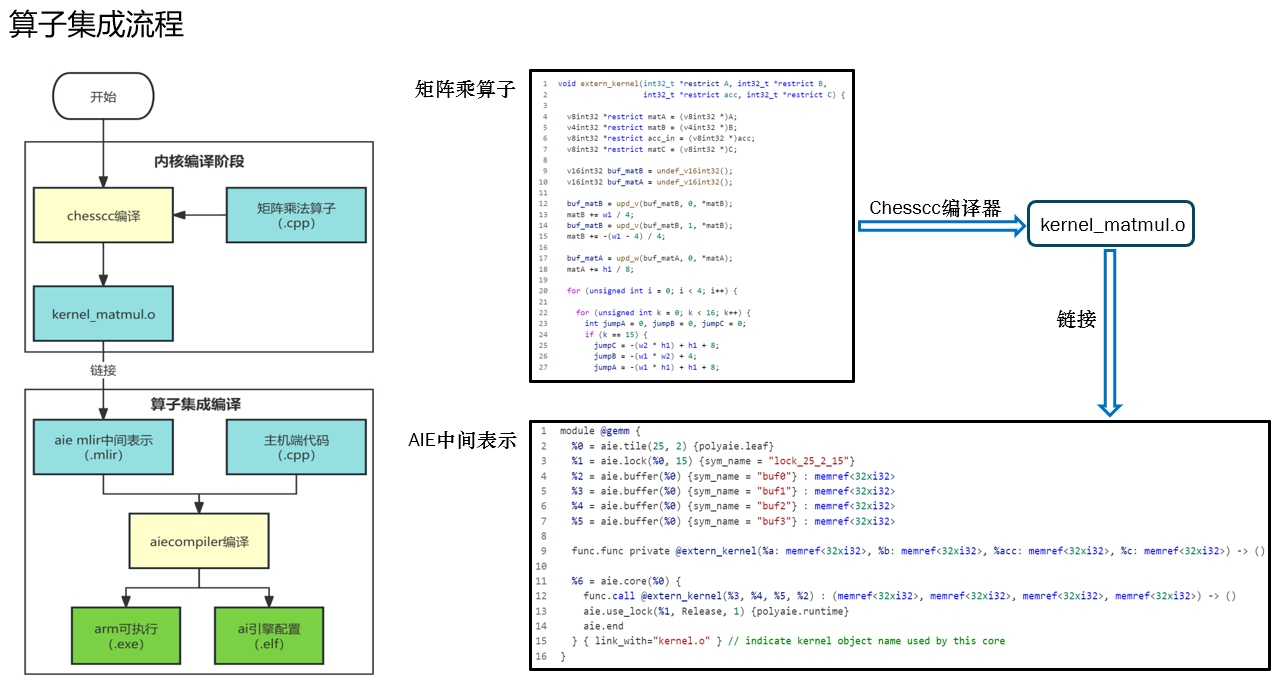1
2
3
4
5
6
7
8
9
10
11
12
13
14
15
16
17
18
19
20
21
22
23
24
25
26
27
28
29
30
31
32
33
34
35
36
37
38
39
40
41
42
43
44
45
46
47
48
49
50
51
52
53
|
module {
func.func @conv2d(%arg0: memref<?x64xi16>, %arg1: memref<?x3xi16>, %arg2: memref<?x32xi16>) attributes {llvm.linkage = #llvm.linkage<external>} {
%c0_i32 = arith.constant 0 : i32
%c0 = arith.constant 0 : index
%0 = aievec.upd %arg1[%c0, %c0] {index = 0 : i8, offset = 0 : i32} : memref<?x3xi16>, vector<16xi16>
%c0_0 = arith.constant 0 : index
%c32 = arith.constant 32 : index
%c1 = arith.constant 1 : index
scf.for %arg3 = %c0_0 to %c32 step %c1 {
%c1_1 = arith.constant 1 : index
%1 = arith.addi %arg3, %c1_1 : index
%c2 = arith.constant 2 : index
%2 = arith.addi %arg3, %c2 : index
%c0_2 = arith.constant 0 : index
%c32_3 = arith.constant 32 : index
%c16 = arith.constant 16 : index
%c32_4 = arith.constant 32 : index
%3 = aievec.upd %arg0[%arg3, %c0_2] {index = 0 : i8, offset = 0 : i32} : memref<?x64xi16>, vector<32xi16>
%4 = aievec.upd %arg0[%arg3, %c0_2], %3 {index = 1 : i8, offset = 256 : i32} : memref<?x64xi16>, vector<32xi16>
%5 = aievec_aie1.mul %4, %0 {xoffsets = "0x03020100", xoffsets_hi = "0x07060504", xsquare = "0x2110", xstart = "0", zoffsets = "0", zoffsets_hi = "0", zstart = "0", zstep = "1"} : vector<32xi16>, vector<16xi16>, vector<16xi48>
%6 = aievec_aie1.mac %4, %0, %5 {xoffsets = "0x03020100", xoffsets_hi = "0x07060504", xsquare = "0x2110", xstart = "2", zoffsets = "0", zoffsets_hi = "0", zstart = "2", zstep = "13"} : vector<32xi16>, vector<16xi16>, vector<16xi48>
%7 = aievec.upd %arg0[%1, %c0_2] {index = 0 : i8, offset = 0 : i32} : memref<?x64xi16>, vector<32xi16>
%8 = aievec.upd %arg0[%1, %c0_2], %7 {index = 1 : i8, offset = 256 : i32} : memref<?x64xi16>, vector<32xi16>
%9 = aievec_aie1.mac %8, %0, %6 {xoffsets = "0x03020100", xoffsets_hi = "0x07060504", xsquare = "0x2110", xstart = "0", zoffsets = "0", zoffsets_hi = "0", zstart = "3", zstep = "1"} : vector<32xi16>, vector<16xi16>, vector<16xi48>
%10 = aievec_aie1.mac %8, %0, %9 {xoffsets = "0x03020100", xoffsets_hi = "0x07060504", xsquare = "0x2110", xstart = "2", zoffsets = "0", zoffsets_hi = "0", zstart = "5", zstep = "10"} : vector<32xi16>, vector<16xi16>, vector<16xi48>
%11 = aievec.upd %arg0[%2, %c0_2] {index = 0 : i8, offset = 0 : i32} : memref<?x64xi16>, vector<32xi16>
%12 = aievec.upd %arg0[%2, %c0_2], %11 {index = 1 : i8, offset = 256 : i32} : memref<?x64xi16>, vector<32xi16>
%13 = aievec_aie1.mac %12, %0, %10 {xoffsets = "0x03020100", xoffsets_hi = "0x07060504", xsquare = "0x2110", xstart = "0", zoffsets = "0", zoffsets_hi = "0", zstart = "6", zstep = "1"} : vector<32xi16>, vector<16xi16>, vector<16xi48>
%14 = aievec_aie1.mac %12, %0, %13 {xoffsets = "0x03020100", xoffsets_hi = "0x07060504", xsquare = "0x2110", xstart = "2", zoffsets = "0", zoffsets_hi = "0", zstart = "8", zstep = "7"} : vector<32xi16>, vector<16xi16>, vector<16xi48>
%15 = aievec.srs %14, %c0_i32 : vector<16xi48>, i32, vector<16xi16>
vector.transfer_write %15, %arg2[%arg3, %c0_2] : vector<16xi16>, memref<?x32xi16>
%c1_5 = arith.constant 1 : index
%16 = arith.muli %c16, %c1_5 : index
%17 = arith.addi %c0_2, %16 : index
%18 = aievec.upd %arg0[%arg3, %17] {index = 0 : i8, offset = 0 : i32} : memref<?x64xi16>, vector<32xi16>
%19 = aievec.upd %arg0[%arg3, %17], %18 {index = 1 : i8, offset = 256 : i32} : memref<?x64xi16>, vector<32xi16>
%20 = aievec_aie1.mul %19, %0 {xoffsets = "0x03020100", xoffsets_hi = "0x07060504", xsquare = "0x2110", xstart = "0", zoffsets = "0", zoffsets_hi = "0", zstart = "0", zstep = "1"} : vector<32xi16>, vector<16xi16>, vector<16xi48>
%21 = aievec_aie1.mac %19, %0, %20 {xoffsets = "0x03020100", xoffsets_hi = "0x07060504", xsquare = "0x2110", xstart = "2", zoffsets = "0", zoffsets_hi = "0", zstart = "2", zstep = "13"} : vector<32xi16>, vector<16xi16>, vector<16xi48>
%22 = aievec.upd %arg0[%1, %17] {index = 0 : i8, offset = 0 : i32} : memref<?x64xi16>, vector<32xi16>
%23 = aievec.upd %arg0[%1, %17], %22 {index = 1 : i8, offset = 256 : i32} : memref<?x64xi16>, vector<32xi16>
%24 = aievec_aie1.mac %23, %0, %21 {xoffsets = "0x03020100", xoffsets_hi = "0x07060504", xsquare = "0x2110", xstart = "0", zoffsets = "0", zoffsets_hi = "0", zstart = "3", zstep = "1"} : vector<32xi16>, vector<16xi16>, vector<16xi48>
%25 = aievec_aie1.mac %23, %0, %24 {xoffsets = "0x03020100", xoffsets_hi = "0x07060504", xsquare = "0x2110", xstart = "2", zoffsets = "0", zoffsets_hi = "0", zstart = "5", zstep = "10"} : vector<32xi16>, vector<16xi16>, vector<16xi48>
%26 = aievec.upd %arg0[%2, %17] {index = 0 : i8, offset = 0 : i32} : memref<?x64xi16>, vector<32xi16>
%27 = aievec.upd %arg0[%2, %17], %26 {index = 1 : i8, offset = 256 : i32} : memref<?x64xi16>, vector<32xi16>
%28 = aievec_aie1.mac %27, %0, %25 {xoffsets = "0x03020100", xoffsets_hi = "0x07060504", xsquare = "0x2110", xstart = "0", zoffsets = "0", zoffsets_hi = "0", zstart = "6", zstep = "1"} : vector<32xi16>, vector<16xi16>, vector<16xi48>
%29 = aievec_aie1.mac %27, %0, %28 {xoffsets = "0x03020100", xoffsets_hi = "0x07060504", xsquare = "0x2110", xstart = "2", zoffsets = "0", zoffsets_hi = "0", zstart = "8", zstep = "7"} : vector<32xi16>, vector<16xi16>, vector<16xi48>
%30 = aievec.srs %29, %c0_i32 : vector<16xi48>, i32, vector<16xi16>
vector.transfer_write %30, %arg2[%arg3, %17] : vector<16xi16>, memref<?x32xi16>
}
return
}
}
|
